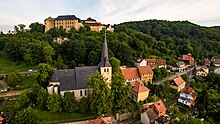St. Bartholomew (Blankenburg (Harz))
The Bergkirche St. Bartholomäus is an Evangelical Lutheran church in Blankenburg (Harz) . It has belonged to the Bad Harzburg provost of the Evangelical Lutheran Church in Braunschweig since 1992 and is a stop on the Harz monastery hiking trail .
Building history
The construction of the three-aisled Romanesque parish church began in 1186/1246 under Count Siegfried II von Blankenburg. 1203, Theodericus plebanus de Blankenburg, the first pastor is mentioned.
In 1252 the parish church was converted into a monastery church for a double monastery (secular monastery and Cistercian nuns). The chancel in the east was extended in the Gothic style, two side chapels were built in the line of the aisles and the nuns' gallery above the southern chapel. The north side of the church received Gothic windows. The renovations were completed under Count Heinrich II. The donor figures in the choir room presumably also date from this time, and they probably represent the four brothers Heinrich II., Hermann (Bishop of Halberstadt), Siegfried and Burchardt (later Archbishop of Magdeburg).
After the canon monastery was abolished in 1305, the nunnery was used to care for the unmarried daughters of the Blankenburg counts and their officials. It was abolished in the course of the Reformation in 1532. This made the St. Bartholomew Church a parish church again. Until the Blankenburg-Regenstein counts died out, the building was also their burial place; the Renaissance tomb of Count Ernst I von Regenstein († 1581) and his wife Barbara on the southern inner wall testify to this. After the construction of the Katharinenkirche, originally built as a garrison church in 1735, which became the main church in Blankenburg, St. Bartholomew lost its importance.
In 1887/91 and 1960/62 the church was completely renovated. Another interior renovation was financed mainly by Duke Ernst August von Hannover in 1990 .
Furnishing
In connection with the conversion to a monastery church, the choir received four donor figures. They show the counts who financed the construction and equipping of the nunnery: on the north side Siegfried II and Siegfried III, who gave the money to found the monastery; on the south side Count Heinrich II. and Bishop Hermann von Halberstadt, who contributed to the financing of the relocation to Blankenburg. In the sacristy there is a sacrament house from the same period.
The renaissance pulpit depicting the virtues of faith (fides) , love (caritas) , hope (spes) and justice (iustitia) was donated in 1582 by the superintendent Leonhard Schweiger . The baroque altar wall in the choir was donated by Duke Anton Ulrich von Braunschweig in 1712. The font was made in 1744 from Rübeland marble.
A cross-shaped memorial was placed in the western entrance area of the church for Duke Friedrich Wilhelm , who fell in 1815 and became famous as the “Black Duke”, and for the fallen residents of the city of Blankenburg.
In 1964, the sacristy received a stained glass window with a motif based on Psalm 124.
organ
In 1676 an existing small organ was expanded. The organ has been overhauled and modified several times over the years. In 1838/39 Wilhelm Boden (Halberstadt) built a new organ in the Romantic style. The pipe material from the previous baroque organ was partially reused. The present organ prospect comes from a renovation in 1866. Another extensive baroque renovation was carried out in 1931 by the Hanoverian organ building firm Furtwängler & Hammer according to the principles of organ movement . In 2009/10 the instrument was completely renovated by Jost Truthman from Frankfurt (Oder) .
|
|
|
|
|||||||||||||||||||||||||||||||||||||||||||||||||||||||||||||||||||||||||||||||||||||||||||||||||||||||||||||||||||
- Coupling : II / I, III / I (also as sub-octave coupling), III / II, III / III (super-octave coupling), I / P, II / P, III / P
Peal
Of the four bronze bells purchased in 1858, three were melted down for war purposes during the First World War and replaced by three cast steel bells in 1922. In 2004 the church received a new ring of three bells, some of which was cast in Lauchhammer.
The bells with the chimes d 'and f' were taken from the old chimes. A bell made of Michaelstein with the tone a ', which was cast during the Nazi era in 1936, was hung up again after a long discussion and a warning board was attached. The big bell is called St. Bartholomäus, the middle one St. Katharina and the small one St. Michael. You should take part in the merger of the formerly independent parishes to form an Ev.-luth. Remember the Blankenburg parish.
Pastor
|
Association for the parish of Blankenburg (Harz)
|
literature
- Heinrich Brinckmann: The Bartholomäus Monastery and the Bartholomäus Church in Blankenburg a / H. , in: Zeitschrift des Harz-Verein für Geschichte und Altertumskunde 19 (1886), pp. 286–312.
- Claudia Lundbeck: St. Bartholomäus Blankenburg , Blankenburg (Harz) 2013.
- Gustav Sander: Church and Monastery of St. Bartholomäus in Blankenburg (homeland sheets for Blankenburg am Harz and the surrounding area, No. 55), Blankenburg (Harz) 1935.
- Karl Steinacker : The problem of the Bartholomäuskirche in Blankenburg a. H. , in: Zeitschrift des Harz-Verein für Geschichte und Altertumskunde 47 (1914), pp. 267–281.
- Karl Steinacker: The architectural and art monuments of the Blankenburg district (The architectural and art monuments of the state of Braunschweig, vol. 6), Wolfenbüttel 1922.
- Rudolf Steinhoff: The Bartholomaeus Monastery and the Bartholomaeus Church in Blankenburg , in: Journal of the Harz Association for History and Antiquity 18 (1885), pp. 161-179.
Web links
Individual evidence
- ↑ organindex.de , accessed on July 22, 2018
- ↑ To the disposition
Coordinates: 51 ° 47 ′ 16 " N , 10 ° 57 ′ 16.2" E




